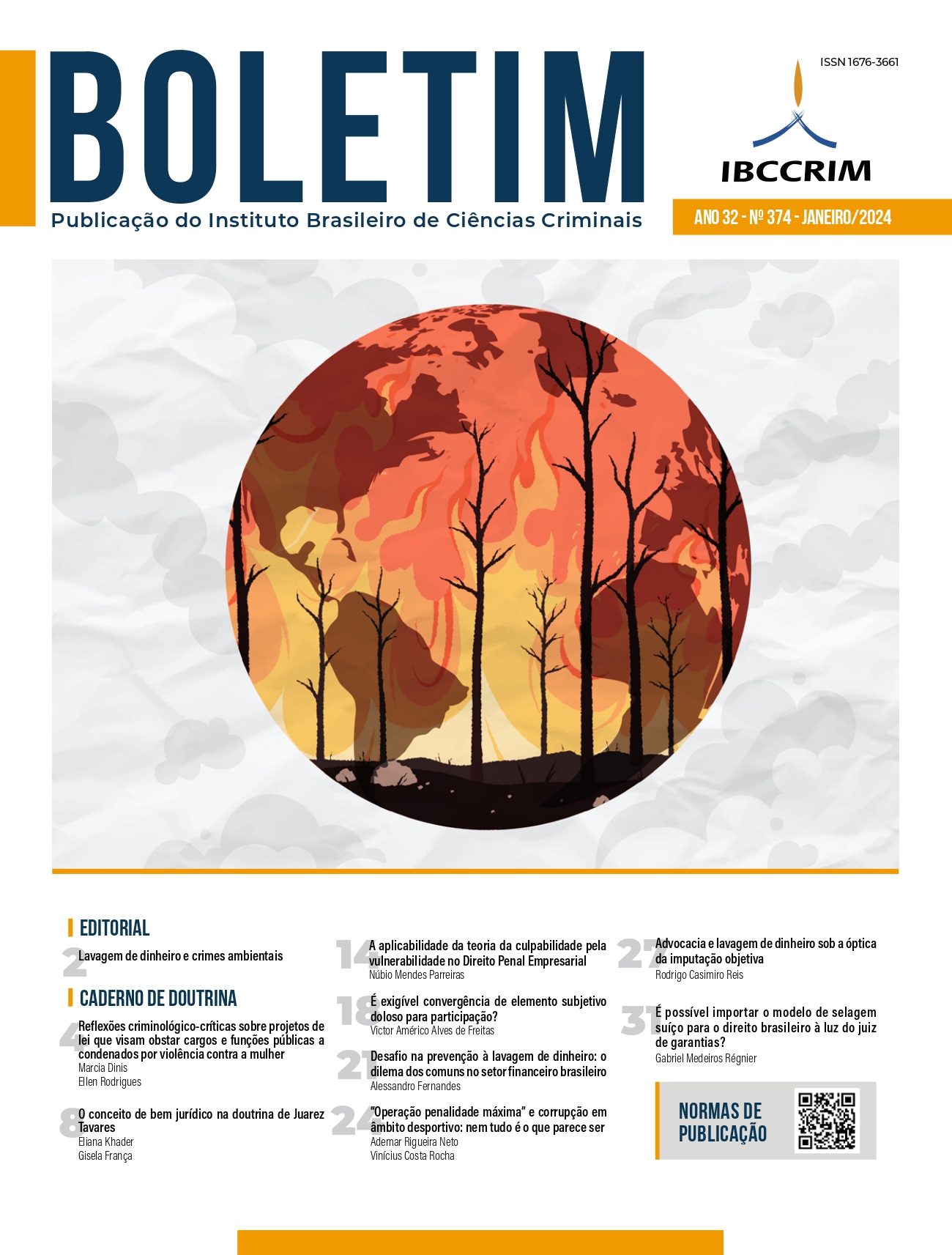Is it possible to import the swiss sealing model into brazilian law under the judge of guarantees ?
Views: 264DOI:
https://doi.org/10.5281/zenodo.10278314Keywords:
Impartiality, Precautionary measures, Guarantee judge, Sealing, Criminal proceedings, Criminal evidence, Comparative LawAbstract
The Swiss Code of Criminal Procedure, in the chapter dedicated to search and seizure, deals with a right to seal that arises from the principlesnemo tenetur se detegere andin dubio pro sigilo. Within a three-phase, double-judge model, the code guarantees the investigated person (and interested third parties) the right to ask the criminal prosecution authority for seized objects to be immediately sealed. The purpose of sealing is to ensure that no one has contact with the seized material before a court decides on this possibility. This court exercises control over criminal evidence and functions as a court of guarantees. From Comparative Law, the text analyzes the Swiss sealing model and its relationship with the guarantee judge of the Brazilian model, with the aim of assessing the possibility of importing the institute into Brazilian law.
Downloads
Publication Facts
Reviewer profiles N/A
Author statements
- Academic society
- Instituto Brasileiro de Ciências Criminais
- Publisher
- IBCCRIM
References
DEPEURSINGE,Camille dePerrier.Code de Procédure Pénale Suisse annoté. 2. ed. Basileia: HelbingLichtenhahn, 2020.
DEPEURSINGE, Camille de Perrier. Entrevista concedida em 2023. DEPEURSINGE, Camille P. Professora Dra. de Direito Penal da Universidade de Lausanne. La mise sous scellés dans le CPP suisse par rapport le CPP brésilien (A selagem do CPP suíço comparada ao CPP brasileiro). Entrevistador: Gabriel Medeiros Régnier. Lausanne, 2023.
GUARNERI, Giuseppe. Las partes en el proceso penal.Puebla: JoseM. Cajica Jr, 1952.
HARARI, CorinneCorminboeuf. Entraide judiciaire en matière pénale et mise sous scellés. In:Regards de Marathoniens sur le droit suisse, Mélanges, publiés à l’occasion du 20ème « Marathon du Droit ». Genebra: Slatkine, 2015.p. 475 à 483. Disponível em: https://harari-avocats.ch/wp-content/uploads/2017/06/25246_diffusion_oag_regards_marathon-43-Corminboeuf-Harari.pdf. Acesso em: 7 dez. 2023.
JOLIVET,Anne. Quels enseignements tirer de l'étude du procès criminel suisse?Les Cahiers de la Justice, Paris, v. 4, n. 4,p.653-664, 2017. https://doi.org/10.3917/cdlj.1704.0653
LOPES JR., Aury; RITTER, Ruiz. Juiz das garantias: para acabar com o faz-de-conta-que-existe-igualdade-cognitiva...ConJur, 8 maio 2020. Disponível em: https://www.conjur.com.br/2020-mai-08/juiz-garantias-fim-faz-conta. Acesso em: 12 maio 2023.
MACALUSO, Alain; ROCHAT, Laurine. Révision du CPP : vers quelques modifications en matière de scellés et de séquestre.Droit Pénal des Affaires, 30 ago. 2019. Disponível em: https://www.droitpenaldesaffaires.ch/legislation/revision-du-cpp-vers-quelques-modifications-en-matiere-de-scelles-et-de-sequestre/. Acesso em: 24 mar. 2023.
MAZOU, Miriam. L’acquittement requis au procès de Mike: interview de Miriam Mazou. Play RTS, 19 jun. 2023. Disponível em: https://www.rts.ch/play/tv/forum/video/lacquittement-requis-au-proces-de-mike-interview-de-miriam-mazou?urn=urn:rts:video:14114494.Acesso em: 6dez. 2023.
MOREILLON, Laurent; PAREIN-REYMOND, Aude. Code de Procédure Pénale: petit commentaire. 2. ed. Basileia: Helbing Lichtenhahn. 2016,
PITOMBO, Cleunice A. Valentim Bastos. Da busca e da apreensão no processo penal.2. ed., rev., atual. e ampl. São Paulo: RT, 2005.
SCHÜRCH, Simone. La portéeduprincipe in dubio produriore, LawInside, 19 set. 2017. Disponível em:https://www.lawinside.ch/500/. Acesso em: 22 jun. 2023.
SILVEIRA, Marco Aurélio Nunes. Por uma teoria da ação processual penal: aspectos teóricos atuais e considerações sobre a necessária reforma acusatória do processo penal brasileiro. Curitiba: Observatório da Mentalidade Inquisitória, 2018.
SUÍÇA. Code de procédure pénale. Suíça: 5 out. 2007. Disponível em:https://www.fedlex.admin.ch/eli/cc/2010/267/fr.Acesso em: 6 dez. 2023.
SUÍÇA. Disponível em: Democracia direta (admin.ch). Acesso em: 8 dez. 2023
VIEIRA, Renato Stanziola. Controle da prova penal: obtenção e admissibilidade. 2 ed. rev. atual. e ampl. São Paulo: Thomson Reuters Brasil, 2023.
Downloads
Published
How to Cite
Issue
Section
License
Copyright of published articles belongs to the author, but with journal rights over the first publication and respecting the one-year exclusivity period. Authors may only use the same results in other publications by clearly indicating this journal as the medium of the original publication. If there is no such indication, it will be considered a situation of self-plagiarism.
Therefore, the reproduction, total or partial, of the articles published here is subject to the express mention of the origin of its publication in this journal, citing the volume and number of this publication. For legal purposes, the source of the original publication must be consigned, in addition to the DOI link for cross-reference (if any).


 Português (Brasil)
Português (Brasil)
 English
English
 Español (España)
Español (España)






